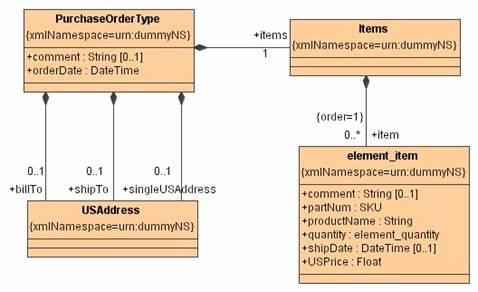The definitions of complex types in the purchase order schema all declare sequences of elements that must appear in the instance document. The occurrence of individual elements declared in the so-called content models of these types may be optional, as indicated by a 0 value for the attribute minOccurs (e.g. in comment), or be otherwise constrained depending upon the values of minOccurs and maxOccurs. XML Schema also provides constraints that apply to groups of elements appearing in a content model. These constraints mirror those available in XML 1.0 plus some additional constraints. Note that the constraints do not apply to attributes.
XML Schema enables groups of elements to be defined and named, so that the elements can be used to build up the content models of complex types. Un-named groups of elements can also be defined, and along with elements in named groups, they can be constrained to appear in the same order (sequence) as they are declared.
To illustrate, we introduce two groups into the PurchaseOrderType definition from the purchase order schema so that purchase orders may contain either separate shipping and billing addresses, or a single address for those cases in which the shippee and billee are co-located:
Figure: Nested Choice and Sequence Groups
<xsd:complexType name="PurchaseOrderType">
<xsd:sequence>
<xsd:choice>
<xsd:group ref="typens:shipAndBill"/>
<xsd:element name="singleUSAddress" type="typens:USAddress"/>
</xsd:choice>
<xsd:element ref="comment" minOccurs="0"/>
<xsd:element name="items" type="typens:Items"/>
</xsd:sequence>
<xsd:attribute name="orderDate" type="xsd:date"/>
</xsd:complexType>
<xsd:group name="shipAndBill">
<xsd:sequence>
<xsd:element name="shipTo" type="typens:USAddress"/>
<xsd:element name="billTo" type="typens:USAddress"/>
</xsd:sequence>
</xsd:group>
Such xsd:group references are resolved by the Importer, therefore they are not visible in the imported classes. Figure 447 depicts the situation where the PurchaseOrderType class contains the shipTo and billTo attributes corresponding to the elements of the imported shipAndBill group which is not visible anymore.
The choice group element allows only one of its children to appear in an instance.
One child is an inner group element that references the named group shipAndBill consisting of the element sequence shipTo, billTo, and the second child is a singleUSAddress. Hence, in an instance document, the purchaseOrder element must contain either a shipTo element followed by a billTo element or a singleUSAddress element. The choice group is followed by the comment and items element declarations, and both the choice group and the element declarations are children of a sequence group. The effect of these various groups is that the address element(s) must be followed by comment and items elements in that order.
The following diagram shows, how this construct gets imported into UML:
Figure: Nested Choice and Sequence Groups imported into UML
The UML class PurchaseOrderType is created in order to hold all possible instances of the XSD PurchaseOrderType. This is meant by the following
For the above example this implies that billTo, shipTo and singleUSAddress elements must be given as optional – that is, lower multiplicity = 0 – associations. billTo and shipTo are defined using an elementGroup element which is explained in the next section. Note that there is nor order tagged value, because the UML attributes and associations are not fully ordered anymore, if there is at least one choice content model present. Which leads to another rule:
There exists a third option for constraining elements in a group: All the elements in the group may appear once or not at all, and they may appear in any order. The all group is limited to the top-level of any content model. Moreover, the group's children must all be individual elements (no groups), and no element in the content model may appear more than once, i.e. the permissible values of minOccurs and maxOccurs are 0 and 1. This content model corresponds exactly to the "content" model of UML classes meaning that:
